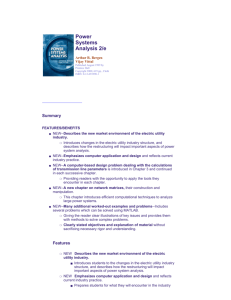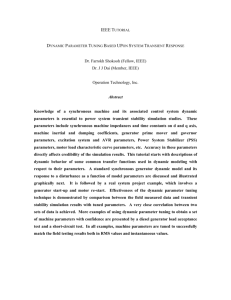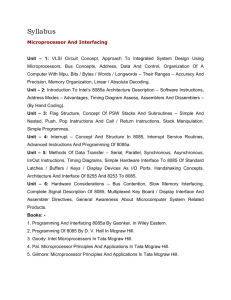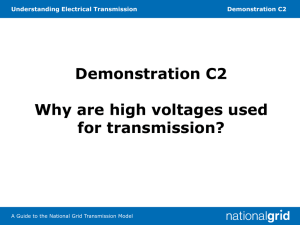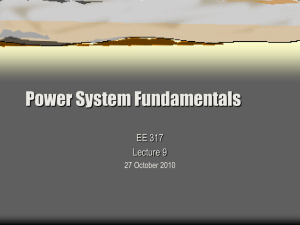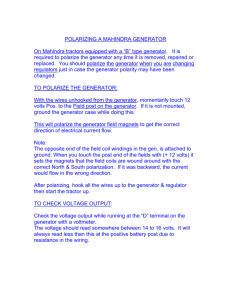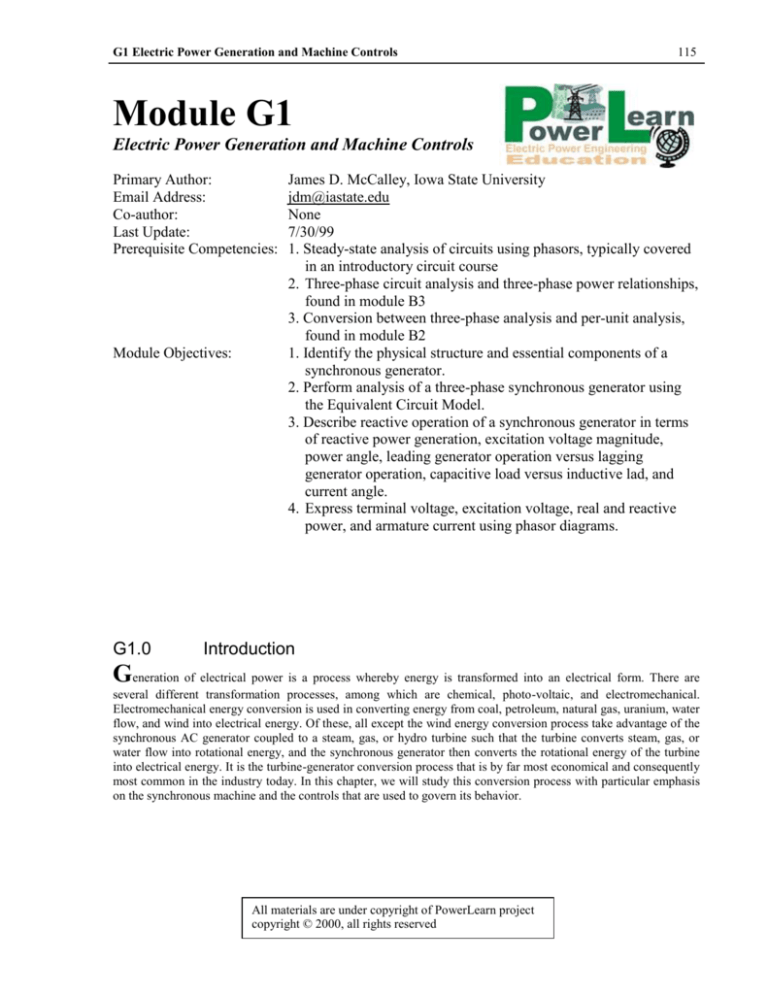
G1 Electric Power Generation and Machine Controls
115
Module G1
Electric Power Generation and Machine Controls
Primary Author:
Email Address:
Co-author:
Last Update:
Prerequisite Competencies:
Module Objectives:
G1.0
James D. McCalley, Iowa State University
jdm@iastate.edu
None
7/30/99
1. Steady-state analysis of circuits using phasors, typically covered
in an introductory circuit course
2. Three-phase circuit analysis and three-phase power relationships,
found in module B3
3. Conversion between three-phase analysis and per-unit analysis,
found in module B2
1. Identify the physical structure and essential components of a
synchronous generator.
2. Perform analysis of a three-phase synchronous generator using
the Equivalent Circuit Model.
3. Describe reactive operation of a synchronous generator in terms
of reactive power generation, excitation voltage magnitude,
power angle, leading generator operation versus lagging
generator operation, capacitive load versus inductive lad, and
current angle.
4. Express terminal voltage, excitation voltage, real and reactive
power, and armature current using phasor diagrams.
Introduction
Generation of electrical power is a process whereby energy is transformed into an electrical form. There are
several different transformation processes, among which are chemical, photo-voltaic, and electromechanical.
Electromechanical energy conversion is used in converting energy from coal, petroleum, natural gas, uranium, water
flow, and wind into electrical energy. Of these, all except the wind energy conversion process take advantage of the
synchronous AC generator coupled to a steam, gas, or hydro turbine such that the turbine converts steam, gas, or
water flow into rotational energy, and the synchronous generator then converts the rotational energy of the turbine
into electrical energy. It is the turbine-generator conversion process that is by far most economical and consequently
most common in the industry today. In this chapter, we will study this conversion process with particular emphasis
on the synchronous machine and the controls that are used to govern its behavior.
All materials are under copyright of PowerLearn project
copyright © 2000, all rights reserved
G1 Electric Power Generation and Machine Controls
G1.1
116
Generator Operation
A turbine-generator is illustrated in its basic form in Figure G1.1.
Figure G1.1 Block Diagram for Turbine-Generator System
The governor and excitation systems are known as feedback control systems because it is the feedback loops which
provide for good control of certain parameters. The governor and excitation systems are typical feedback controllers
in that the quantities to be controlled (speed and voltage, respectively) are also providing the feedback signal. We
will study these controllers more closely. However, we must first take a closer look at the operation of the generator
itself.
The generator is classified as a synchronous machine because it is only at synchronous speed that it can develop
electromagnetic torque. If the nominal system frequency is f (60 Hz in North America), synchronous speed is
computed as
m
2
e
p
(G1.1)
where e 2f is the frequency in rad/sec and p is the number of poles on the rotor of the machine. The machine
120
f .
speed in RPM can be computed as N s
p
The synchronous generator has two iron structures. The rotor is the revolving part of the machine, and is located
inside the stator, which is the stationary part of the machine. Hydroelectric generators have their rotors built with
saliency; the rotor poles protrude from the central axis. Because hydro-turbines are relatively slow (600 to 1800
RPM hydro-turbine generators are typical ), the number of poles must be high in order to produce 60 Hz voltages
(see eqn. G1.1). Salient pole construction is simpler and more economical when a large number of poles are
required.
Steam plants, on the other hand, have very high speeds (1800 and 3600 RPM steam-turbine-generators are typical),
and saliency would create significant mechanical stress at these speeds. Therefore, smooth or round rotor
construction is employed for these generators. The two types of rotor construction are illustrated in Figure G1.2.
G1 Electric Power Generation and Machine Controls
117
Figure G1.2 Salient Pole (left) and Smooth (right) Rotor Construction
A magnetic field is provided by the DC-current carrying field winding, which induces the desired AC voltage in the
armature winding. For synchronous generators, field winding voltages are typically much lower in magnitude than
armature winding voltages; in addition, armature voltages must be available external to the machine. It is therefore
simpler to locate the armature winding on the stator where there is no rotation. The field winding is always located
on the rotor where it is connected to an external DC source via slip rings and brushes or to a revolving DC source
via a special brushless configuration. The armature consists of three windings, all of which are wound on the stator,
physically displaced from each other by 120 degrees. It is through these windings that the electrical energy is
produced and distributed. A typical layout for a 2 pole, smooth rotor machine would appear as in Figure G1.3.
Figure G1.3 Winding Layout for Two-Pole Smooth Rotor Synchronous Machine
A complete theoretical analysis of synchronous machine operation is beyond the scope of this course, but there are
many good texts on the subject; a representative sample of these is [2,3,4]. It will suffice here to discuss the basics
of steady-state, balanced operation only.
G1.2.1
The Revolving Magnetic Field
The DC current in the revolving field windings on the rotor produces a revolving magnetic field. We denote the flux
associated with this field that links the armature windings as f (the subscript “f” indicates field windings). By
Faraday’s Law of Induction, this rotating magnetic field will induce voltages in the three armature windings.
Because these three windings are physically displaced by 120 degrees (for a two-pole machine), the induced
voltages will be phase displaced in time by 120 degrees.
G1 Electric Power Generation and Machine Controls
118
If each of the three armature windings is connected across equal impedances, balanced three phase currents will
flow in them. These currents will in turn produce their own magnetic fields. We denote the flux associated with each
field as a , b , and c . The resultant field with associated flux obtained as the sum of the three component
fluxes a , b , and c is the field of armature reaction. We designate the associated flux as ar . Using
electromagnetic field theory and a trigonometric identity, one can show that ar revolves at the same velocity as the
rotor. Therefore the two fields represented by f and ar are stationary with respect to each other. The armature
field is effectively “locked in” with the rotor field and the two fields are said to be rotating in synchronism. The total
resultant field is the sum of the field from the rotor windings and that associated with armature reaction:
r ar f .
G1.2.2
The Phasor Diagram
From Faraday’s Law of Induction, a voltage is induced in each of the three armature windings according to
d
v N r where is the number of winding turns. Because r is a sinusoidal function of time, the negative sign
dt
captures the fact that the induced voltage will lag the flux by 90 degrees. Letting E r , E ar , and E f be the voltages
induced in winding a by the fluxes r , ar , and f , respectively, we can represent the relationships in time
between the various quantities using the phasor diagram, illustrated in Figure G1.4.
φf
φar
φr
Ef
Ear
Ia
Er
Figure G1.4 Phasor Diagram for Synchronous Machine
Regarding Figure G1.4, take note that
All voltages lag their corresponding fluxes by 90 degrees.
The current in winding a, denoted by I a , is in phase with the flux it produces ar
If I a 0 (no load conditions), then ar 0 , and in this case,
All resistances have been neglected.
G1.2.3
r F , and Er E F .
The Equivalent Circuit Model
We develop the equivalent circuit model for winding a only; the same model applies to windings b and c with
appropriate 120 degree phase shifts in all currents and voltages, assuming balanced operation such that the loading
on each winding is the same.
G1 Electric Power Generation and Machine Controls
119
From Figure G1.4, the component voltages are related via
E r E f E ar
(G1.2)
However, because
Ear N
d ar
dt
and ar is directly proportional to I a (assuming constant permeability), we can write that
Ear ( K ) I a .
Assuming ar is sinusoidal, the angle must be -90 degrees; therefore the constant of proportionality K must be a
reactance, which we will denote as X ar . These changes result in
Ear ( X ar 90o ) I a or Ear jX ar I a
Substitution into eqs.(G1.2) yields
E r E f jX ar I a
We obtain the terminal voltage by subtracting from E r , a voltage drop caused by I a to account for the leakage flux.
This refinement results in
Vt E r jX l I a E f j ( X l X ar ) I a
Defining X s X l X ar as the synchronous reactance, we have that
Vt E f jX s I a
The circuit model corresponding to this equation is illustrated in Figure G1.5.
Figure G1.5 Equivalent Circuit Model of Synchronous Machine
The phasor diagram corresponding to the equivalent circuit, when the load is inductive, is shown in Figure G1.6.
G1 Electric Power Generation and Machine Controls
120
Figure G1.6 Phasor Diagram for Equivalent Circuit – Inductive Load
The phasor diagram corresponding to the equivalent circuit, when the load is capacitive, is shown in Figure G1.7.
Figure G1.7 Phasor Diagram for Equivalent Circuit – Capacitive Load
Vt ; the generator is said to be operating “lagging.”
When the load is capacitive, the current I a leads the voltage Vt ; the generator is said to be operating “leading.”
The angle between I a and Vt is i, i.e., I a | I a | i if Vt | Vt | 0 . This implies that
When the load is inductive, the current I a lags the voltage
i 0 lagging, i 0 leading
Example
G 1.1
A 10 MVA, 3 phase, Y-connected, two pole, 60 Hz, 13.8 kV (line to line) generator has a synchronous reactance of
20 ohms per phase. Find the excitation voltage E f if the generator is operating at rated terminal voltage and
supplying (a) 300 Amperes at 30 degrees lagging, (b) 300 Amperes at 30 degrees leading.
Solution
Vt
13 .8kV
3
7.97 kV Vt 7.97 10 3 0V
E f Vt jX s I a
(a) I a 300 30 A E f 7.97 10 3 0 (2090)(300 30) 12.1425.34kV
(b) I a 300 30 A E f 7.97 10 3 0 (2090)(300 30) 7.1946.27kV
G1 Electric Power Generation and Machine Controls
121
Note that the excitation voltage magnitude | E f | is much higher in the lagging case. We sometimes refer to the
lagging case as overexcited operation; here we have that | E f | cos | Vt | , where is the angle between E f and
V t . The leading case results in under-excited operation; in this case we have E f cos Vt .
G1.2.4
Power Relationships
From our equivalent circuit in Figure G1.5, we write that Vt E f jX s I a . Solving for I a yields
E f Vt
Ia
jX s
Define the power angle, , where E f | E f | , Vt | Vt | 0 so that
is the angle at which the excitation
voltage leads the terminal voltage. Therefore,
Ia
| E f | Vt 0
Ia
jX s
| E f | sin
Xs
| E f | cos j | E f | sin Vt
jX s
| E f | cos Vt
jX s
| E f | cos Vt
j
Xs
j | E f | sin
jX s
(G1. 3)
But
I a | I a | cos i j | I a | sin i | I a | cos j | I a sin | .
(G1.4)
since v i and v 0 because Vt | Vt | 0 is the reference phasor.
Equating
I a sin
real
and
E f cos Vt
Xs
imaginary parts
of
eqns.
G1.3
and
G1.4,
we
have
I a cos
E f sin
Xs
and
. Multiplying both sides of the previous equations by 3Vt yields
Pout 3Vt I a cos
Qout 3Vt I a sin
3Vt E f sin
(G1.5)
Xs
3Vt E f cos
Xs
2
3Vt
Xs
(G1.6)
In eqn. G1. 6, reactive power out of the machine is positive when the machine is operated overexcited, i.e., when it
is lagging implying i 0 .It is important to realize that eqns. G1.5 and G1.6 are based on the assumption that stator
winding resistance is zero.
G1 Electric Power Generation and Machine Controls
Example
122
G 1.2
Find Pout and Qout for the conditions (a) and (b) described in the previous example.
Solution
(a) 25 .34 , Vt 7.97 kV , | E f | 12 .14 kV
Pout
3(7.97 10 3 )(12.14 10 3 ) sin 25.34
6.21MW
20
Qout
3(7.97 10 3 )(12 .14 10 3 ) cos 25 .34 3(7.97 10 3 ) 2
3.59 MVAR
20
20
(b) 46 .27 , Vt 7.97 kV , | E f | 7.19 kV
Pout
3(7.97 10 3 )(7.19 10 3 ) sin 46.27
6.21MW
20
Qout
3(7.97 10 3 )(7.19 10 3 ) cos 46 .27 3(7.97 10 3 ) 2
3.59 MVAR
20
20
The student should consider the following questions regarding this example:
Why is real power the same under the two conditions?
When the generator is operating lagging, is it absorbing VAR from or supplying VAR to the network? What
about when the generator is operating leading?
For a particular angle , are the terms “lagging” and “leading” meaningful with respect to real power? With
respect to reactive power?
G1.2.5
Generator Pull-Out Power
From eqs.(G1.5), the electrical power output Pout can be plotted against the power angle , resulting in sinusoidal
variation as shown in Figure G1.8.
Figure G1.8 Power Angle Curve
G1 Electric Power Generation and Machine Controls
123
For simplicity, and without loss of generality, we neglect all real power losses associated with windage and heat loss
in the turbine and friction in turbine and generator bearings. Continuing with the assumption that stator winding
resistances are zero, in steady-state operation, the mechanical power input to the machine is equal to the electrical
power: Pmech Pout . (In reality, Ploss 0 in steady-state operation so that Pmech Pout Ploss .) Consider what
happens to this lossless machine operating at Pout Pmax ( 90 ) when the steam valve opening is increased so
that Pmech becomes slightly larger. In this case, the power angle increases beyond 90 , and the electrical power
begins to decrease. However, the mechanical power is only dependent on the steam valve opening, i.e., it is
unaffected by the decrease in Pout . This can only mean that Pmech Pout . The difference Pmech Pout causes the
machine to accelerate beyond its synchronous speed. When this happens, we say that the machine has “pulled out,”
“gone out of step,” or “lost synchronism.” The generation level at which this happens is called the pull out power. It
is given by
3Vt E f
Pm ax
Xs
This limit is lower when the generator is under-excited (leading current) because E f is lower.
Example
G 1.3
Compute the pull-out power for the two conditions described in Example G1.1.
Solution
(a) Overexcited case (lagging):
Pmax
3(7.97 10 3 )(12 .14 10 3 )
14 .51MW
20
(b) Under-excited case (leading):
Pmax
G1.3
3(7.97 10 3 )(7.19 10 3 )
8.6MW
20
Excitation Control
In examples G1.1 and G1.2, we saw two different conditions, summarized as follows:
a. I a 300 30 (lagging), E f 12 .14 25 .34 kV , Qout 3.59 MVAR (supplying)
b. I a 300 30 (leading), E f 7.19 46 .27 kV , Qout 3.59 MVAR (absorbing)
We recall that in both conditions, the terminal voltage was constant at Vt 7.97 0kV . One observes that although
terminal voltage is constant, E f and Qout are not. These effects are achieved via control of the generator field
current, which produces the field flux f . Field current control can be done manually, but it is also done
automatically via the excitation control system.
G1 Electric Power Generation and Machine Controls
124
The excitation control system is an automatic feedback control having the primary function of maintaining a
predetermined terminal voltage by modifying the field current of the synchronous generator based on changes in the
terminal voltage. Without excitation control, terminal voltage would fluctuate as a result of changes in Pout or
external network conditions. The control is referred to as “negative feedback” because when terminal voltage
increases, field current is decreased, and when terminal voltage decreases, field current is increased. A simplified
block diagram of an excitation control system is shown in Figure G1.9.
Figure G1.9 Block Diagram of Excitation Control System
There are three fundamental components to any excitation system. The main exciter, or more simply, the exciter, is
the device that provides the field current for the synchronous generator. The automatic voltage regulator (AVR)
couples the terminal voltage to the input of the main exciter. The amplifier increases the power of the regulating
signal to that required by the exciter. If the amplifier is electromechanical, it is called the pilot exciter or the rotating
amplifier. If the amplifier is solid state, it is usually considered as part of the AVR.
There are three basic types of excitation systems. These are:
rotating DC commutator
rotating AC alternator
static
These are illustrated in Figures G1.10, G1.11, and G1.12.
Figure G1.10 Rotating DC Commutator Type Excitation System
G1 Electric Power Generation and Machine Controls
125
Figure G1.11 Rotating AC Alternator Type Excitation System
Figure G1.12 Static Type Excitation System
The DC commutator excitation system utilizes a DC generator mounted on the shaft of the synchronous generator to
supply the field current. This type of system is no longer used in new facilities because it is slow in response, and
because it requires high maintenance slip rings and brushes to couple the exciter output to the field windings.
The AC alternator excitation system uses an AC alternator with AC to DC rectification to supply the field winding
of the synchronous generator. An important advantage over DC commutator systems is that AC alternator systems
may be brushless, i.e., they do not use slip rings to couple the exciter to the rotor-mounted field winding. For
example, the General Electric Althyrex uses an “inverted” alternator to supply the field voltage through a rectifier.
The alternator is inverted in that, unlike the power generator, the field winding is on the stator and the armature
windings are on the rotor. Therefore the alternator field can be fed directly without the need for slip rings and
brushes. Rectification to DC, required by the synchronous generator field, takes place by feeding the alternator
three-phase output to a thyristor controlled bridge. The thyristor or silicon controlled rectifier (SCR) is similar to a
diode, except that it remains “off” until a control signal is applied to the gate. The device will then conduct until
current drops below a certain value or until the voltage across it reverses. This device will be further discussed in
Chapter 7.
The third type of excitation system is called a static system because it is composed entirely of solid state circuitry,
i.e., it contains no rotating device. The power source for this type of system is a potential and/or a current
transformer supplied by the synchronous generator terminals. Three-phase power is fed to a rectifier, and the
rectified DC output is applied to the synchronous generator field via slip rings and brushes. Static excitation systems
are usually less expensive than AC alternator types, and the additional maintenance required by the slip rings and
brushes is outweighed by the fact that static excitation systems have no rotating device.
G1 Electric Power Generation and Machine Controls
G1.4
126
Turbine Speed Control
We have already seen that the mechanical speed of a synchronous generator
m
(rad/sec) is related to the
electrical frequency f through m 2f (2 / p) where p is the number of poles. This implies that control of speed
also means control of frequency. But what causes frequency to deviate from its nominal value of 60 Hz?
If you consider your own daily use of electricity, you will realize that the load level seen by supplying generators is
constantly changing, and at least one generator must compensate for these changes. In discussion of pullout power,
we saw that when Pmech Pout , the generator accelerated. In the same way, if Pout is greater than the load, PL , the
generator will also accelerate, resulting in a frequency increase; if Pout is less than PL , the generator will decelerate,
resulting in a frequency decrease.
The effect of a generation-load imbalance on frequency, and the relation between generator speed and frequency,
offers an elegant way to maintain a generation-load balance: use deviation from rated turbine speed
( m,ref 2f (2 / p), f 60 ) as a control signal to cause appropriate action regarding adjustment of the energy
supply valve. If Pout PL , causing m m, ref , the difference signal m m, ref m is fed back to an actuator,
which adjusts the energy supply valve so as to reduce the energy supply and thus reduce Pout . Likewise, if
Pout PL , causing m m,ref , the difference signal m m,ref m is fed back to an actuator, which adjusts
the energy supply valve so as to increase the fuel intake and thus increase Pout . The actuator, which accomplishes
these actions, is called the speed governor. A simplified block diagram of the complete speed governing control
system is shown in Figure G1.13.
Figure G1.13 Block Diagram of Speed Governing Control System
The purpose of frequency control is not only to maintain power balance, but also to protect frequency-sensitive
loads from experiencing large frequency excursions. Some types of loads are designed to operate best at nominal
frequency, and the performance of these loads may degrade substantially when frequency deviates from its nominal
value. Frequency sensitive loads include some types of motor drives, electronic loads (including computers), and
clocks. In North America, frequency is normally regulated to remain within 0.04 % ( 0.02 Hz), but this is
considered “tight;” many power systems in other regions of the world are operated under “looser” regulation.
Indeed, there is ongoing debate in the U.S. today regarding loosening the frequency control criterion.
Because speed-governors act to maintain load balance and frequency constancy, the overall control system of which
they are a part is often referred to as load-frequency control. The speed-governor constitutes what is known as the
primary control; the higher level aspects of load frequency control are known as secondary control and constitute
automatic generation control (AGC). We will not discuss AGC here.
Speed governing equipment for steam and hydro turbines are conceptually similar. Most speed governing systems
are one of two types; mechanical-hydraulic or Electro-hydraulic. Electro-hydraulic governing equipment use
electrical sensing instead of mechanical, and various other functions are implemented using electronic circuitry.
G1 Electric Power Generation and Machine Controls
127
Some Electro-hydraulic governing systems also incorporate digital (computer software) control to achieve necessary
transient and steady state control requirements. The mechanical-hydraulic design, illustrated in Figure G1.14, is used
with older generator units.
Figure G1.14 Mechanical-Hydraulic Governor Design
Basic operation of this feedback control system for turbine under-speed is indicted by movement of each component
as indicated by the arrows. As m decreases, the bevel gears decrease their rotational speed, and the rotating
flyweights pull together due to decreased centrifugal force. This causes point B and therefore point C to raise.
Assuming, initially, that point E is fixed, point D also raises causing high pressure oil to flow into the cylinder
through the upper port. The oil causes the main piston to lower, which opens the steam valve (or water gate in the
case of a hydro machine), increasing the energy supply to the machine in order to increase the speed.
If rod CDE was not connected at point E, the previous actions would provide constant frequency, as long as no more
than one machine in the system was regulating. However, if two or more machines were regulating, each machine
would continuously “correct” frequency changes made by the others, i.e. they would “fight” each other. The
connection at point E solves this problem. This connection forces point D to move down slightly as point E moves
down. This action provides for a nonzero steady state frequency deviation according to pu RPpu where R is
called the steady state droop or regulation constant, and pu 1 and Ppu are the per unit steady state deviations in
frequency and power, respectively. The so-called steady state droop characteristic is illustrated in Figure G1.15.
Figure G1.15 Steady-State Droop Characteristic
1
Per unit frequency deviation is given by
pu / 377 f / 60
when 60 Hz is the nominal frequency.
G1 Electric Power Generation and Machine Controls
Example
128
G 1.4
Two machines on speed-governor control are interconnected and supplying the same load when the load suddenly
increases such that the steady state frequency deviation is 0.01 Hz. If both machines have a droop of 5%
( R 0.05 ), machine A is rated at 100 MW and machine B is rated at 200 MW, compute the steady state deviation
in power for each machine.
Solution
A sudden increase in load will decelerate the machine and therefore frequency must decrease.
0.01
pu
0.000167
60
0.000167
Ppu , A
0.0033
RA
0.05
0.000167
Ppu , B
0.0033
RB
0.05
PA (0.0033 )(100 ) 0.33MW
PB (0.0033 )( 200 ) 0.66 MW
The student should answer the following questions:
1.
2.
3.
Why is steady state frequency deviation the same for both machines?
Why is the steady state change in per unit power the same for both machines?
Basic intuition might suggest that, for a given load change, we would like all machines to respond, but “bigger
machines should respond more than smaller machines.” By studying the above example, you should be able to
state a simple requirement regarding coordination of governing systems that would provide for this.
A key point is that the droop characteristic does result in nonzero steady state frequency deviation. This frequency
deviation must be corrected so that the system frequency returns to 60 Hz. This is the function of the secondary
load-frequency control loop, to be discussed in Chapter 5.
G1.5
Summary
The operating costs of generating electrical energy is determined by the fuel cost and the efficiency of the power
plant. The efficiency depends on generation level and can be obtained from the heat rate curve. We may also obtain
the incremental cost curve from the heat rate curve. In Module E3 it is illustrated how this very important generator
characteristic is used to find optimal (least cost) allocation of demand among all of the interconnected generators.
The AC synchronous machine is the most common technology for generating electrical energy. It is called
synchronous because the composite magnetic field produced by the three stator windings rotate at the same speed as
the magnetic field produced by the field winding on the rotor. We use a simplified circuit model to analyze steadystate operating conditions for a synchronous machine. The phasor diagram is an effective tool for visualizing the
relationships between internal voltage, armature current, and terminal voltage. The excitation control system is used
on synchronous machines to regulate terminal voltage, and the turbine-governor system is used to regulate the speed
of the machine.
G1 Electric Power Generation and Machine Controls
References
A. Bergen, Power Systems Analysis, Prentice-Hall, New Jersey, 1986.
V. Del Toro, Electric Power Systems, Prentice-Hall New Jersey, 1992.
P. Kundur, Power System Stability and Control, McGraw-Hill, New York, 1994.
W. Stevenson, Elements of Power System Analysis, 4th edition, McGraw-Hill, New York, 1982.
D. Fink and H. Beaty, editors, Standard Handbook for Electrical Engineers, 13th edition, 1993, Graw-Hill, Inc.,
New York.
L. Matsch, Electromagnetic and Electromechanical Machines, 2nd edition, Ahrper and Row, new York, 1977.
A. Fitzgerald, C. Kingsley, and A. Kusko, Electric Machinery, 3rd edition, McGraw-Hill, New York, 1971.
V. Mablekos, Electric Machine Theory for Power Engineers, Harper and Row, Cambridge, 1980.
S. Dewan and A. Straughen, Power Semiconductor Circuits, John Wiley and Sons, New York, 1975.
P. Anderson and A. Fouad, Power System Control and Stability, The Iowa State University Press, 1977.
E. Kimbark, Power System Stability, Synchronous Machines, Dover Publications, 1956.
129
G1 Electric Power Generation and Machine Controls
130
PROBLEMS
Problem 1
A three-phase, 60 Hz generator has a synchronous reactance of 0.9 / and negligible resistance. The generator is
delivering 50MW at 0.8 power factor lagging. The terminal voltage remains constant at 30kV line to line throughout
this problem.
(a) Determine the excitation voltage per phase (angle and magnitude ) and the reactive power out of the machine.
(b) With the field current held constant at the level of part (a), the mechanical power into the machine is reduced to
25MW. Determine the reactive power out of the machine.
(c) With the machine initially generating 50MW at 0.8 power factor lagging, as in part (a), a change is made so that
the excitation voltage is reduced to 79.2% of its value. Determine the reactive power out of the machine.
Problem 2
A three-phase, 6-pole, 60 Hz, Y-connected synchronous generator has a synchronous reactance of X S 2 / . It is
operating so that the terminal voltage is constant at 13.8kV line-to-line. The three-phase real power output of the
machine is 6MW. Assume the line-to-neutral terminal voltage is the reference (angle = 0 degree) for all calculation
below.
a. What is the synchronous speed of this generator in RPM?
b. The excitation voltage magnitude is 19kV line-to-line. What is the power angle delta (the angle between the
excitation voltage and the terminal voltage) ? Based on this answer, indicate whether the generator is operating
leading or lagging and how you can tell.
c. What is the magnitude and angle of the current I a ? Based on this answer, indicate whether the generator is
operating leading or lagging and how you can tell.
d. Compute the three phase reactive power out of the machine. Based on this answer, indicate whether the generator
is operating leading or lagging and how you can tell.
Problem 3
In each of the following questions circle the answer that is most likely to be correct based only on the information
for that question and the following two sentences. In all cases a single generator is directly connected to a single
load. All voltages are line to neutral.
i)
A generator is supplying 20 MVAR to a load. The angle 'theta' of the load impedance is ____.
a) negative
b) zero
c) positive
d) not enough information
ii) The terminal voltage of a generator is 4.50 kV. The excitation voltage is 530 kV. This generator is
operating with a power factor that is ______.
a) leading
b) unity c) lagging
d) not enough information
iii) A generator has an armature current of I a 5020 A when the terminal voltage is 50 kV. The
generator is _______.
a) overexcited
b) under-excited c) neither
d)not enough information
iv) The excitation voltage of a generator is very large in magnitude. The load is
_______.
a) resistive
b) inductive
c) capacitive
d) not enough information
v) The real power output of a generator is positive. The current is ________ the terminal voltage.
a) leading
b) in phase with c) lagging
d) not enough information
G1 Electric Power Generation and Machine Controls
131
vi) The load is inductive. The angle of the terminal voltage is 0 degrees. The angle of the current is _______.
a) positive
b) negative
c) zero
d) not enough information
vii) The DC current to the field winding is very small. The generator is ________ reactive power.
a) supplying
b) absorbing
c) neither
d) not enough information
viii) The angles of the excitation voltage and the terminal voltage are both 0 degrees. The real power of the
machine is ________.
a) positive
b) negative
c) zero
d) not enough information
ix) The real power consumed by the load suddenly increases. The system frequency will ___.
a) increase
b) decrease
c) stay the same d) not enough information
x) The system frequency increases. The speed of the machine must have ________.
a) increased
b) decreased
c) stayed the same
d) not enough information
Problem 4
Draw a rough sketch of a three-phase two-pole smooth-rotor synchronous generator. Label the stator, rotor, field
winding, and armature winding.
Problem 5
Why are the armature windings in a three-phase two-pole synchronous generator spaced 120 degrees apart?
Problem 6
In Germany normal appliances use 50 Hz AC power. What is the ideal speed (in RPM) of the rotor in a three-phase
four-pole synchronous generator supplying this power?
Problem 7
Why is it necessary to control the speed of the turbine? What would the problem be (for power consumers) if the
turbine speed were not controlled? In a broad sense, how is control of turbine speed accomplished?
Problem 8
A three-phase synchronous generator is operating with terminal voltage (line-to-neutral) of 127.020 V. Its perphase internal excitation voltage is E f 132.9810.23 V. The synchronous reactance is X s 2 .
a)
b)
c)
d)
e)
f)
Compute the three phase real power out of the generator.
Compute the three phase reactive power out of the generator.
Compute the total current supplied by the generator.
Draw the phasor diagram for this operating situation. Show terminal voltage, internal voltage, and
current.
Indicate whether this operating condition is leading or lagging.
Compute the angle of E f (denoted as delta) required if the operating condition were changed so
that the magnitude of E f remains unchanged, but the reactive power being produced by the
generator is zero (i.e. unity power factor).
G1 Electric Power Generation and Machine Controls
132
Problem 9
A three-phase synchronous generator, having rated terminal voltage (line-to-line) of 220 volts, is operating so that
its per-phase internal (excitation) voltage is E f 132.9810.23 V. Assume constant terminal voltage at rated
voltage. The synchronous reactance is X s 2 .
a)
Compute the reactive power out of the generator.
b)
The field current is now changed so that the reactive power supplied by the machine is 600 VAR.
The real power out of the machine is 3kW. Find the excitation voltage E f (magnitude and angle).
Problem 10
A three-phase synchronous generator is supplying a load over a transformer connected to a transmission line. The
circuit is illustrated below.
Impedance data (in per-unit) are: X t 0.06, Rt 0.01, X x 0.10, X g 0.95
+
V1 = V t
-
Operating information:
+
V3
-
+
VL
-
V1 1.00, PL 0.80, Q L 0.20, E g 1.51430.45
V3 0.97 4.77, I a 0.87 21.7
Base Voltages:
Base Power:
13.8kV, 230kV
100MVA
a)
Draw the vector diagram, showing Vt , E g , and I a for this operating condition. Also, redraw the phasor
b)
diagram for the case when QL 0.20 per-unit. It is unnecessary to do calculations, but the length and
angles of the three vectors relative to each other should be approximately correct. Identify each phasor
diagram as either leading, lagging, or neither.
Compute the real and reactive power supplied at the generator terminals (at bus 1), in MW and
MVAR.
c)
d)
Compute the real and reactive power flowing into the transmission line from bus 3, in MW and
MVAR.
Are the answers to (b) and (c) different? Why or why not?
Problem 11
X S 3 / . The terminal
voltage of the generator is Vt 13.8kV (line-to-line) and the armature current is I a 400 30 (referenced
A Y-connected three-phase synchronous generator has a synchronous reactance of
to line-to-neutral terminal voltage). (a) Compute the internal voltage phasor of the machine, Ef (line-to-neutral). (b)
Determine the magnitude of this phasor, |Ef | necessary to provide 0 vars reactive power out of the machine
terminals, assuming that the angle of this phasor, Ef , is held constant at the value obtained in your calculation of
part (a).
G1 Electric Power Generation and Machine Controls
133
Problem 12
A synchronous generator having synchronous reactance of X S=2 ohms is operating with an 18.0 line-to-line terminal
voltage. The power out of the machine terminals is P out=140 MW, Qout=0.
a.
b.
Compute the magnitude |Ef| and angle of the internal (excitation) voltage.
A large reactor (e.g., inductive element) is suddenly connected in parallel with the load RL, and the
field current is adjusted. Indicate what would happen to each of the below by checking the appropriate
space:
Field current
increase______ decrease_____
Reactive power out of the generator
increase______ decrease_____ no change_____
Current
lead_________ lag_________ neither________

